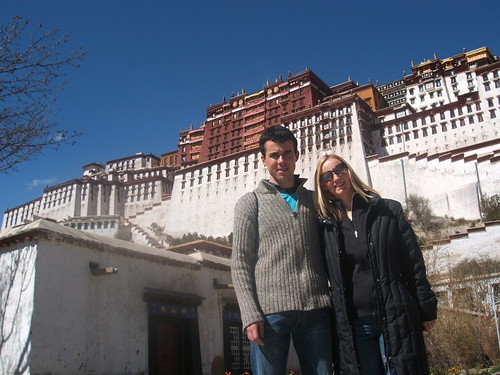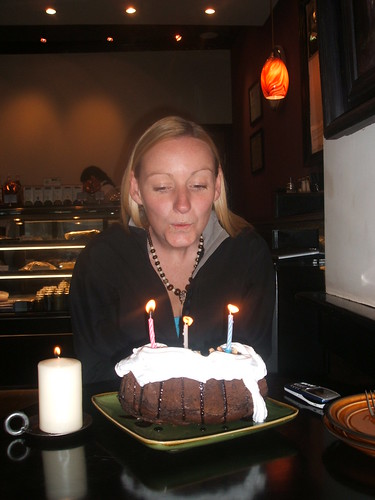Lhasa, Tibet
 Sunday to Friday, 22 - 27 October 2006
Sunday to Friday, 22 - 27 October 2006We fly to Lhasa, the capital of Tibet. The new Beijing-Lhasa Express is booked out for months in advance. Taking the train would have made it easier to adjust gradually to the altitude. Instead, for the first two days in Lhasa (at 3650 metres) we are slowed down a bit. Physically, we feel as if we're constantly walking uphill. Headaches and light-headedness come and go. It takes a while to complete challenging mental exercises (like figuring out which way is up on the street map or Pepsi versus Coca Cola). We don't do much and have to be content with watching CCTV9, China's English-language "news" channel, and the sports channel which seems to show nothing but a continuous loop of badminton.
Our hotel is in the western half of the city where the Han Chinese live (as opposed to the native Tibetans). While not quite ethnic cleansing, there are signs everywhere of China aggressively settling Han Chinese in the city. There is an obvious military presence here. It is clear that China is concerned about the stability of the "Tibet Autonomous Region" and this is nowhere more evident than at the Potala Palace. This is the traditional seat of the Tibetan government and former residence of the Dalai Lama. Nervous that this could be the centre of a revolution, just as it was in 1959 after which the Dalai Lama had to flee the country, soldiers and surveillance cameras abound within the palace, keeping an eye on the caretaker monks.
In the Tibetan half of the city, the atmosphere is completely different. Lhasa means "place of the gods" and Buddhist pilgrims from all over the country converge here. The Jokhang Temple and the pilgrim circuit around it, the Barkhor, are filled with a moving mass of monks and pilgrims, chanting, swinging their prayer wheels and prostrating themselves on the worn flagstones outside the temple. Inside the darkly-lit temple, incense mixes with the smell of rancid yak butter. Yak butter is a big part of Tibetan life and is used here as a kind of candle wax. The smell of it is pretty bad but there's no escaping it. Some Tibetans smear themselves in it as a form of sunblock. It is also used to make yak butter tea which tastes woeful (think of a mix of sour butter and sweaty sports socks left in the sun for a fortnight: it's WMD in a teapot).
We visit the Sera monastery outside Lhasa. It's the site every afternoon for public debates among about 100 monks from the monastery. The format is as follows: one monk stands, facing one to two monks sitting crossed-legged on the ground. The standing monk makes an assertion/puts a question of Buddhist theology to his counterpart(s). He rolls his prayer beads up his left arm, leans back on one foot, raises his right arm to the sky and marks each point by lurching towards his opponent(s), spearing his right hand at them and clapping it against his left hand. He lets out a yelp as well for added effect. It's a bizarre scene. The monks are of all ages. Some are very young novices who don't seem bothered about the whole thing until the supervisor monk comes around with his clipboard. Others are showmen and like to perform for the crowd of tourists looking on. A bit of footage can be seen here.
We make an overnight trip to Samye monastery, about 100km from Lhasa. Our guide tells us a bit more about the buddhas and icons we see in the temples. He tells us that among the buddhas shown, some are "bad buddhas" and have their faces covered so that people cannot look on them. However they cannot be removed from the temples because some Tibetans believe in them. With bad buddhas knocking about the place it seems that buddhism is not as straightforward as sitting under a tree and waiting for enlightenment...

Our week in Tibet witnessed a big event as well: Leahanne's birthday! It wasn't quite dinner at the Ritz but we had chocolate birthday cake at The Tibet Summit Fine Art Cafe where the staff did a good job of singing "Happy Birthday to You" (drowning out Dara's tone-deaf wailing) and followed this up with yak burgers and fries at the Dunya restaurant. We're also getting the hang of Skype (telephone calls over the internet) so it was great to be able to call Leahanne's Mum, Miriam, in Dungarvan on the day.
For more photos, click here.

0 Comments:
Post a Comment
<< Home